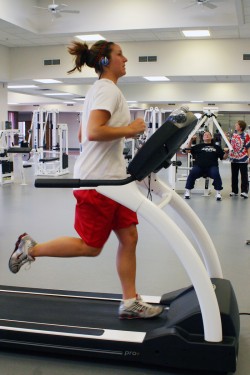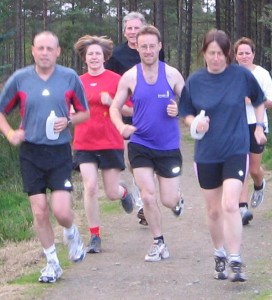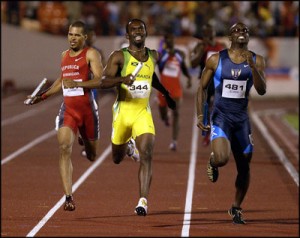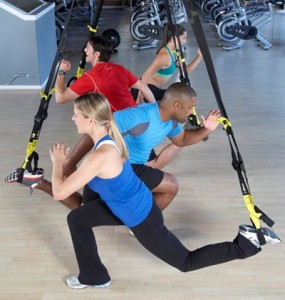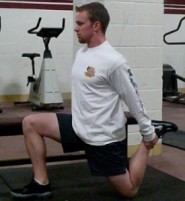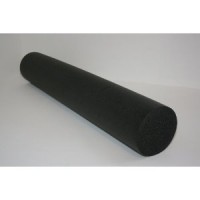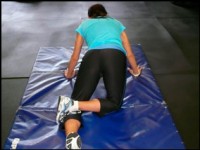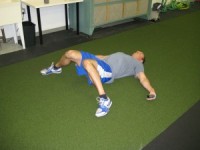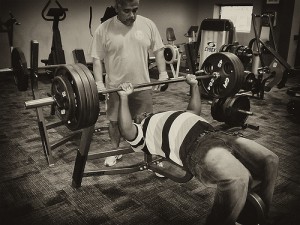5 Fitness Tips for The Laughing Cow…
July 5, 2010 by danny · Leave a Comment
 When the good people from The Laughing Cow asked me to provide them with 5 fitness tips, I was happy to help out. Here is what I came up with…
When the good people from The Laughing Cow asked me to provide them with 5 fitness tips, I was happy to help out. Here is what I came up with…
1) There is no ‘magic trick’ to improving your body; train, eat, sleep, and repeat. Those that are consistent, disciplined, and give everything they have, can bring their health, physique and performance to a new level.
My Current Training Program: Part II
June 24, 2010 by danny · Leave a Comment
Ok, I’m back to finish showing you what my current training program looks like. If you recall from Part I, my main goal right now is to be lean and muscular – since we have entered “beach season.” A side goal is to maintain my strength and size while stripping away a bit of fat. Since I am not eating a ton of extra calories, I am not looking to add a bunch of muscle or bring up lagging body parts. That will be saved for the non-summer months. Here is a recent photo taken of me…
Beware of my two vicious dogs. If you even think about breaking into my house, they will rip your head off. Without further adieu, here is day 3 and 4;
Training Program
Day 3 (This day falls on a Thursday)
A1) Neutral Grip Pull-ups - 3 X 1, 1 X 5 ***
A1) Decline DB Chest Press – 3 X 1, 1 X 7 ***
B1) Rope Pushdowns, Close-Grip Push-ups – 3 X 10 on the pushdowns, and then after the last set of pushdowns, I go right into 1 set of as many reps as possible of close-grip push-ups
B2) Farmer’s Walks – 1 X 50 seconds, 1 X 40 seconds, and 1 X 30 seconds
B3) Face Down (on an incline) reverse flyes (angle of bench set @ about 60 degrees) 3 X 10
Notes*** I do 4 sets of 3 on weeks 2 & 3 for the pull-ups (so, 4 X 3 and 1 X 5). And then on week 4 I go back to the same volume as in week one. I do 4 sets of 5 on the decline press on weeks 2 & 3 (so 4 X 5, 1 X 7) and then on week 4 I go back to the same volume as in week one.
Day 4 (falls on a Saturday)
A1) “Quad” Complex – Barbell Jump Squats X 10, followed immediately by 10 Squats, and finished up with a deep squat holds for as long as possible. I performed 2 sets on week 1. If I could walk and had anything left in my quads I have the option to do 3 sets in weeks 2 & 3. Week 4, back to 2 sets no matter what. (video seen below)
A2) Fillers – anything that is a low level activation drill and/or some extra mobility work (basically to stay productive instead of just sitting there on my butt waiting for the next set to begin).
B1) 1-Leg Back Extensions – 3 X 7/Leg
B2) Lateral Pallof Press – 3 X 5 reps with a 3 second hold on each rep (holding above head)
C) BB Glute Bridge – 2 X 12-15
Wrap Up
So there you have it, my 4-day upper/lower split. I have a higher volume light(er) upper and lower day, and a low(er) volume, heavier day for both the upper and lower body. My cardio is done 1 or 2 days per week. I either do 400 meter “sprints” (soooooo hard) or hill sprints. And most important of all to achieving my goal, is nutrition. If you are having a hard time reaching your physique goal(s), here is a great place to start nutrition-wise. If you are stuck in a rut and need some assistance designing the most effective program for your goals, check out my services page. I’d love to help you reach your goals!
My Current Training Program
June 22, 2010 by danny · Leave a Comment
I thought I’d share my current training program with you today. First of all, here are my goals and a little bit about me;
That’s me from last year’s 4th of July parade. Ok, moving along to more about me…
-It’s summer time so my #1 goal is to look lean and muscular while at the pool.
-With that said, I certainly do not want to become weaker and lose my muscle mass.
-My training (in the weight room) doesn’t change a whole lot (definitely some) while in a “cutting phase.” The main difference for me is to simply add a little more cardio, and to decrease my cals a bit.
-I don’t think it is real smart to do a “specialization” program (like trying to bring up your delts) when calories aren’t as high. I’ll save that for fall and the rest of the non-summer months.
I wouldn’t train the *majority* of my clients this way, (and there would definitely be some modifications if I were training one of my athletes – whose main goal is obviously sports performance) but since I am one of the “lucky” ones, my training doesn’t need to change much in order to lose fat. I put lucky in quotations because I really don’t consider it too lucky that it is fairly easy for me to get a 6-pack. Yes, that part is cool. But believe me, it is not fun to have to eat 42,000 cals by noon every day just to maintain weight. I have to eat 42,000 cals plus eat a camel just to see the scale go up an ounce. All that chewing (and drinking shakes) gets real old, real fast. Alright, with the news and notes out of the way, let’s get to it.
Training Program
Day 1 (this happens to fall on a Monday in this current training block)
A1) Incline DB Press, BB Incline Press - 4 X 8-10 and 1 set of AMRAP (As Many Reps As Possible) with 135 lbs for the barbell press ***
A2) DB Hammer Curls, Upper 1/2 Chins - 3 X 8-10 and then 1 set of AMRAP of upper 1/2 chins (hang from the bar @ 90 degrees and pull myself up to the bar – keep that range of motion (ROM) the entire time. ***
B1) Lateral Raise, Standing DB Shoulder Press – 3 X 12 and on the last set go right into standing shoulder presses for a set of 10 (this is known as the pre-fatigue method).
B2) X-Pulls (a back exercise) 3 X 10
B3) Quadruped Hip Extension (seen below) for 1 X 15-20/leg and 1-Leg Hip Thrust for 1 X 10-15/leg
Notes *** On weeks 2 and 3 I add a set of Incline DB Presses (so 5 X 8-10) and a set of DB Hammer Curls (so 4 X 8-10). Week 4, go back to the same volume as in week 1. This is mainly an upper body day, but I incorporate some glute work in there because it is always good to remind those glutes how to fire efficiently which will help reduce the chance of hamstring and low back problems (as well as help performance in sports). Even know tomorrow is a leg day, I don’t think a couple body weight lower body exercises will impede tomorrow’s workout. Today was higher volume, and as you’ll see, Thursday’s upper body day will be heavier, lower rep training.
Day 2 (falls on a Tuesday)
A1) Trap Bar Deadlift (seen below) – pick a weight that is a 4-6 rep max (RM) and do as many sets as it takes until I hit 15 reps (yes, this is Chad Waterbury-esque) ***
A2) Fillers – anything that is a low level activation drill and/or some extra mobility work (basically to stay productive instead of just sitting there on my butt waiting for the next set to begin)
B1) BB Bulgarian Split Squat (seen below) (lower 1/3 for 3 “mini-reps” then all the way up = 1 rep) – 3 X 5 ***
B2) Swiss Ball Leg Curl – 3 X 10/Leg
B3) RKC Plank – 1 X 30 seconds, Hanging Knee Raises – 1 X 10 to 15
Notes*** On week’s 2 & 3 I go until I hit 20 reps on the deads, and I perform 4 sets on the bulgarian split squats. Week 4 is back to the same volume as week 1. This is my lower rep leg day and day 4 will be be my higher rep leg day.
Alright, I’ll stop here before this thing gets too long. Be sure to check back in later this week to see what days 3 & 4 look like. I know it’s going to be hard to wait, but please, try not to lose any sleep over it. ![]()
Exercise of the Week
June 13, 2010 by danny · Leave a Comment
Today’s exercise of the week is the Lateral Pallof Press. We’ve been using the “regular” Pallof Press with clients for sometime now (I believe I first learned it from Eric Cressey). The original version is a great “anti-rotation” exercise. For those of you that are not familiar with the anti-rotation version (one of the main roles of the core is to resist rotation), here is a video for you…
If this is your first time seeing this version of the Pallof Press, you get a 2 for the price of 1 as far as new exercises to add to your workouts. For those of you that have not seen the Lateral Pallof Press, let’s get to it.
Lateral Pallof Press
I just found out about this exercise about a week ago. I got if from Coach Nick Tumminello. Nick uses a much higher percentage of is brain than I. After watching him go over the Lateral Pallof Press in one of his videos, I thought to myself, “DOH, why didn’t I think of that!?!” (refer to the higher percentage of brain usage above) Anyway, the purpose of this exercise of to prevent lateral flexion (think bending sideways). Your core must fire like crazy to prevent you from bending sideways/getting thrown into the cable.
As you can see in the video, I set up so that the cable is to the side of me. I then set the handle so it is up overhead. Next, I grab it and bring it to my chest area. I then brace my core (squeeze my abs really hard) and push my arms up overhead. The longer I make my arms, the harder the movement. Pick a weight that really challenges you (trust me, if you do these right, you’ll feel your abs/obliques really working), but not a weight so heavy that you can’t keep good form. Good form means to keep your arms long, and your shoulders and hips level throughout. There are a number of different rep options, and you can hold each rep above your head as long as you wish. I usually go with about 5 reps above head, with each rep held for 3 seconds.
The majority (not all) of your “core” training needs will be covered if you incorporate McLarty Rollouts, the Pallof Press variations, and use BIG compound movements in your training. So there you have it. Give Lateral Pallof Presses a shot and you’ll have a stronger, healthier core.
Q & A: The Treadmill
June 7, 2010 by danny · Leave a Comment
Q: Danny, I have lost most of my weight by doing intervals on the treadmill. Since summer is here, I would rather run outside than go to the gym but I am worried the weight will come back because I will be sprinting on my own instead of on a treadmill…make sense? Should I be worried about that, or do you think I will be fine doing intervals outside?
A: I get this, should I run outside or on the treadmill question, quite a bit. While neither is necessarily wrong, I do prefer non-treadmill running. I’d much rather see you run outdoors (or indoors if it is on an indoor track, for example). And here’s why…
The treadmill switches your hams and glutes off. When your foot hits the treadmill, the belt pulls you through. So, the belt does much of the work for you as your leg goes back. Again, taking your hams and glutes out of play. This is a problem for a few reasons;
1) You burn less calories on a treadmill (as opposed to “real” running).
2) The contribution from the quads is still there, so this can lead to an imbalance which can lead to an injury (knees won’t like you). Awhile back I read an article that Strength CoachAlwyn Cosgrove contributed to, and here is what he wrote in regards to this imbalance;
“Walking a mile is about two thousand reps in the sagittal plane at about one and a half to two times your bodyweight. Jogging would be around fifteen hundred total reps at about two to three times your bodyweight.
And since the treadmill switches your hamstring and glutes off — your foot hits the belt and the belt pulls you through — it’s mainly a quad exercise.
So let’s say a client does three miles three times per week for one year (and I’m being conservative).
That’s 6000 reps x 3 days per week x 52 weeks, which equals 936,000 reps of knee extension work. Or 468,000 reps per leg.
Let’s say the load going through with the knee was a measly 100 pounds. That’s 4.6 million pounds of work for the quad with absolutely no hamstring work.
Think of it this way: if you did 400,000 reps of triceps extensions with 100 pounds you’d get four million pounds of volume. If you didn’t balance that out with biceps curls you’d expect the elbow joint to hurt, right? You’re damn straight it would!
So long term walking or running on the treadmill is almost guaranteeing knee pain. And that’s not even the worst part. Since the hamstring is switched off you’re actually burning even less calories than you would if you were to walk on the ground!”
3) The mechanics of running on the treadmill are not the same as “real” running as hip flexion angle increases (affecting the whole hip extensor mechanism) – this will lead to substitution patterns and even further increase your chances of injury (now your knees REALLY, REALLY, REALLY don’t like you).
The Winter
Growing up in Illinois, I know it would be a lot for me to ask you to go run outside when you looking at a negative 23 wind chill. Therefore, I won’t ask you do that (man, I’m too nice). You can get just as good of a cardio workout indoors, without ever stepping on a treadmill. For many people, I prefer “non-traditional” ways to get your cardio in, as I talked in this post. Below is an example from that previous post I made…
When it comes to crappy weather, no excuses! ![]()
If for whatever reason you love to run on the treadmill, I’m not saying that you should never step foot on it again. But for the above reasons, it would be wise for you to use sparingly. And in a perfect world, not use the t-mill at all. After all, who wants to burn less calories per session? Who want to increase their chances of injury (in the long term)? And who wants to jump on a machine that alters running mechanics, further increasing your chances of injury? Not I. One more thing; try to run on a good surface as much as possible. Something like “field turf,” a track, or some grass that is not too bumpy. These options are much easier on the joints than the hard streets and sidewalks. Enough typing, I’m going to go lift and lower heavy things, and then go find a nice hill to sprint up. Multiple times. Now that sounds like some fun, doesn’t it?!?
Should I Run? Part II
May 28, 2010 by danny · 2 Comments
In part I I gave you my thoughts on “distance” running (20 minutes or more of non-stop running/jogging). If you recall, I mentioned that I would prefer that you more evenly spread the stress throughout your body. And that running is very, very repetitive – the same joints take on the same amount of stress in the same fashion throughout your thousands of steps at each running session. Again, this greatly increases your chance of getting a stress fracture as well as other injuries. Below you will see a couple examples of ways to mix your cardio up while sparing your joints in order keep you healthy in your attempt to reach your fat loss and/or conditioning goals.
This first circuit is very “joint friendly.” It is low impact and is great for anyone, especially those that have quite a bit of fat to lose (again, because the low impact nature of these movements, as opposed to running). In this circuit we have body weight squats, followed by hand walks on a step, and finally kettlebell swings. As you can see, the knees take on a bit of stress with the squats, the wrists and shoulders take on a bit of stress with the hand walks, and the low back takes on a little stress with the kettlebell swings. We have some, but not a ton of stress getting distributed all over the body. This is much more conducive to long term joint health.
The 3 exercises in this video are step ups with knee drive, medicine ball slams, and split squat jumps. For the overweight individual the first two exercises are great as they are low impact. I would not use the split squat jumps for someone needing to drop quite a few pounds. For everyone else, all of the exercises from both videos are great.
So, if you are looking for a more fun, joint friendly way to get your cardio in, please consider incorporating fast paced, circuit style cardio. And remember, if you LOVE running, I’m not asking you to stop altogether. I’m just asking you to consider my points as to why it would be smart to incorporate some “different” kinds of cardio. So, reduce (or completely eliminate) the repetitive stress that long(er) running brings, and have some fun doing it!
Should I Run?
May 25, 2010 by danny · Leave a Comment
To run or not to run, that is the question. Running/jogging is something people having been doing for years and years. And I believe it is something that people looking to drop a few pounds will continue to do ’til the end of time. But, is running the best way to “get in shape” and lose weight? Is it even a good way at all? While reading my thoughts below, please don’t think I am biased towards the weight room and power/strength activities due to the fact that I am a strength coach. If anything, my natural bias would be towards distance running as I grew up in a house where my dad was a cross country coach. And one of my brothers is currently the head cross country coach at a high school. I’ve completely thought about both sides of the discussion – running is the best way EVER to lose some weight; and running is a crap form of cardio for weight loss. I’m not saying I have all answers, but again, I’ve put a ton of thought into this over the years, worked with a ton of clients and talked with many other coaches in this field about this topic. So, if at the end of this you disagree with me, that is fine. All I ask is that you read with an open mind and consider my thoughts when making up your mind whether or not you should put much time into running to accomplish your goals. For the sake of this post, I’m talking about a distance that takes 20 minutes or more of non-stop running.
Different “Types” of People
Running For Sports – (Remember, throughout this piece I am speaking of going out on runs/jogs that last 20 minutes or more, non-stop) For most sports, I think running is a bad idea. What sport do you know that involves 20 + minutes of non-stop running? I can think of cross country. If I think hard enough I may be able to come up with a couple more. But most sports involve quick bursts followed by a brief rest. i.e. player sprints all out for 10-15 seconds, the ball goes out of bounds, he/she takes a break, the ball is thrown in bounds and this is repeated throughout the course of the game. For cross country, heck yeah you need to get your distance running in. If you compete in cross country, make sure you run distance, but also make sure you incorporate sprints and weight lifting. If all you do is run long distance at a slower than race pace, you’ll become good at running slow. Not good! Here is a great read from strength coach Eric Cressey for cross country (or those that are out of high school and enjoy competing in road races) runners and coaches talking about the importance of resistance training for runners.
The Person Looking to Drop Some LBS. – I think I first heard this quote from Strength Coach Mike Boyle; “Don’t run to get fit, get fit to run.” In other words, if you have weight to lose, and you decide, “hey, I think I am going to start running on Wednesday,” then you are probably not making a wise decision. Any form of cardio we decide to do is going to cause stress to our joints. But some forms of cardio will cause more than others. And for a person that is a bit heavier, running will cause a high amount of stress to the joints. It will also increase the chance of stress fractures and all kinds of other problems. Not only that, but running is VERY repetitive. I believe it is estimated that running one mile takes about 2000 steps. Go out and run 3 miles, two times per week and we’re talking about 12,000 steps in the same fashion… you are basically an injury waiting to happen. In this case, I’d suggest lower impact activities like using the Airdyne Bike.
The Already Fit Person – For the person that is lean, and in good shape (although that is very subjective), I still don’t like the idea of long(er) steady state running a whole lot. The exception is the person that truly loves running. He/she gets a whole lot of joy out of it and looks forward to his/her weekly (or even daily) running sessions. However, from the people I’ve talked to and worked with, the majority (read: not ALL) of people run because they think this is the best, or only option of cardio for fat loss – rather than running because they truly enjoy it. Hey, we only live one life, and who and am to take away one of your loves in life?!? But for those of you that are reading this that fit in the category of; “I hate going out for long runs but I’ve always done it because I thought I was supposed to in order to lose weight,” you’re in luck. Like I’ve been alluding to, there are other forms of cardio that have you losing just as much, if not more fat, while sparing your joints.
Even if you fit in the, “I love running camp,” I highly suggest you mix it up and do NOT just do long(er) steady state runs for your cardio. Think of the example I gave above… 12,000 steps per week (and something tells me that if you love to run, you are probably running more than 2 times per week, and more than 3 miles per pop. If that is the case, you are taking WAY more than 12,000 joint pounding, repetitve steps per week). If you love it, my suggestion is to still do it, but reduce the amount considerably. Maybe one day is a 6 mile run. The second day you do some interval sprints (yes, your joints still take a pounding with sprints, but if you do ten 50-meter sprints, think about how much you reduce the total amount of steps you take).
And on the 3rd day, you mix up the form of cardio you are going to perform. This is my favorite way, because you more evenly distribute the force throughout your body, greatly reducing the force placed on a joint(s). In part II of “Should I Run,” I will go over a few examples of how to make cardio more fun (at least myself and the majority of my clients say it is more fun ![]() ). And more importantly, ways to make cardio more joint friendly.
). And more importantly, ways to make cardio more joint friendly.
Conclusion
As you can see, besides a few exceptions (cross country runners and those that truly love it) I’m not a big fan of steady state running/jogging. In my opinion, the risk:reward ratio is way out of whack for the majority of people. As Memorial Day Weekend, and hot summer days approach, I KNOW the #1 goal for most people is to lean out and look good at those pool parties. If you dread running as a form a cardio, you are not alone. Be sure to check back later this week for some “fun,” very effective alternatives. Beach-ready bodies, here we come – no excuses! ![]()
Are Your Knees Always Sore?
May 17, 2010 by danny · Leave a Comment
Knee pain is a very common problem. Especially for those that are in their 30s and 40s (although I know plenty of 20-somethings with sore knees as well). During my last couple years of playing competitive basketball, my knees were always hurting. And the first two or three years (especially after playing pick-up games) it was even worse. I told myself; I know, I know, I need to stretch more. This every once in awhile stretching thing is not good enough. So I finally made a point to stretch every day. But, it didn’t help! Why? All I would do is stretch my hamstrings because some doctor told me to do that about 10 years earlier. Don’t get me wrong, there are plenty of people out there that need to stretch their hammies (including your truly), but this doesn’t do a whole lot to address sore knees. Fast forward a few years (and a TON of reading later), and I now better understand how to make my (and your) knees feel better. While I am no knee expert (I’ll leave to guys like Mike Robertson), I feel confident that if you integrate the below tips, your knees will be thanking you in a big way!
This is in no way the end-all-be-all of “knee tips” for healthy knees. But I thought I’d include a few simple tips that you can incorporate today, to get your knee(s) feeling better.
Tips For To Make Your Knees Love You
1) Stretch Your Quads
As I mentioned above, all the hamstring stretching in the world isn’t going to do a whole lot when trying to address sore knees. When I started stretching my quads (more specifically – my rectus femoris), I started feeling considerably better.
2) Get Your Soft Tissue Work In
If you’ve been reading this website for awhile now, this is probably the 311th time you’ve heard my mention the importance of soft tissue work. Foam rolling your IT-Band, and your vastus lateralis (outside part of your quads) will do wonders for your knees. Breaking up the knots in your glutes will also help. And if you are feeling really tough, using a lacrosse ball for your glutes and TFL is even better!
You can purchase your roller here at performbetter. I NEVER do a leg workout or play basketball without first getting some soft tissue work in. Make sure you do the same – this means before you go golfing; before your slow pitch softball games; before your wii bowling tourney; etc. etc.
Oh, and rolling afterwards and on “off” days would be smart too.
3) Improve Hip Mobility/Flexibility
Mike Robertson and Eric Cressey have done a great job of teaching us about the importance of improving hip mobility. Before each activity, make sure you do some dynamic movement that help make your hips more mobile. A couple of good drills…
Working on flexibility of the hips/glutes is also smart. A couple examples…
I usually perform these static stretches post-workout and on “off” days.
4) Activate Your Glutes
I mentioned above that I always perform soft tissue work before my leg workouts. Another thing I always do, is perform some kind of “glute activation” drill. A drill like X-Band Walks are perfect here. Sometimes when I am demonstrating how to squat to a new client, my knees are achy just by using the 45-pound bar. But, if I perform X-Band walks before demonstrating, the pain is completely gone. X-Band walks will help to get the glute max and posterior fibers of the glute medius firing. This will take tension off of the knees.
Once again, you can pick up these “Superbands” at performbetter.
Quick Story
A few months back one of my “older” (57 years old) clients walked into the gym and said; “Danny, my knees are killing me! There is NO WAY I am going to be able to perform any lower body movements today. Let’s just focus on upper body.” I said, not so fast. Let’s at least try a few “tricks” before giving in so easily. His reply; “it’s just not going to happen, it hurts just to stand here. But ok, I’ll humor you.” So, I had him try a body weight squat. He went down about 3 inches and immediately stopped; “they’re just too sore!” I had him roll out his IT-Band and vastus lateralis on the foam roller. And then use the lacrosse ball on his glutes and TFL. Next I told him to stand up and try another body weight squat. He went down a few inches – no pain. He went deeper and deeper until he was ass-to-grass. “Danny, what are you, like some kind of voo-doo witch doctor,” he asked? Well, I wish I was magic, but we simply used this soft tissue work to get some of those knots out. It is AMAZING how freely and pain free our body moves once we “untie” the knots in our body. We then performed some mobility drills, X-Band walks, and went onto have a great, pain-free session.
If working out, whether it be weight training, pick-up basketball games, or running around with your kids, is no longer any fun because of those achy knees, you’re now 4 simple tips closer to moving around without all that pain!
Exercise of the Week
May 10, 2010 by danny · Leave a Comment
I usually tell trainees to make sure they use a full range of motion (ROM) with every rep of every set. But, just like with most things in life, there is a time and place to “break the rules.” Planning to do an exercise with a reduced ROM can be very smart to increase overall strength and/or hypertrophy (grow bigger). Just to be clear, I do not like the idea of reducing ROM mid-set because you are too tired to finish the set the way your started it. If form starts to break down during the set, or you can’t keep as much ROM as you did on rep #1, stop the set. But, if you go into the set with a plan to perform the entire set with partial ROM, then I’m cool with it (as long as you do this OCCASIONALLY, and NOT all the time Mr. 1/4 depth squatter).
Every guy that has ever lifted a weight has bench pressed before. Us strength coaches often joke that Monday is “National Bench Press Day” because if you walk into just about any gym in America you’ll see guys waiting in line to get their bench press in.
I’m not against the bench press per se. But I do believe the world be a better place if guys put just a touch less emphasis into their bench, and a bit more emphasis in bringing up their chicken legs. And when I say, “just a touch less emphasis into their bench,” what I really mean to say, is that I wish most guys would cut their bench work in 1/2 – AT LEAST! If you are bench pressing every week, the chances of developing a shoulder injury will increase. And this leads us to the exercise of the week. The pin press.
Pin Press
The pin press is a great variation of the bench press. The reduced ROM will help to keep your shoulders healthy. It is also a great exercise for the triceps. Your pecs and anterior delts will come into play as well. Another benefit of temporarily reducing your ROM with lifts, is that you can use more weight. This will allow your nervous system to get used to the bigger load, allowing you to use more weight when you return to full ROM pressing. In the video below I set up the pins so they put my arm at about a 90 degree angle. You can also set the pins a little higher or lower.
Now, I’m not going to ask you to stop benching forever. That would be like me asking Hubie Brown to go more than 3 minutes without making reference to a “high percentage shooter,” – just aint gonna happen. I am going to ask you however, to reduce the amount of time you spend bench pressing, and to start incorporating the pin press. Please? Now go get some horseshoe triceps…





